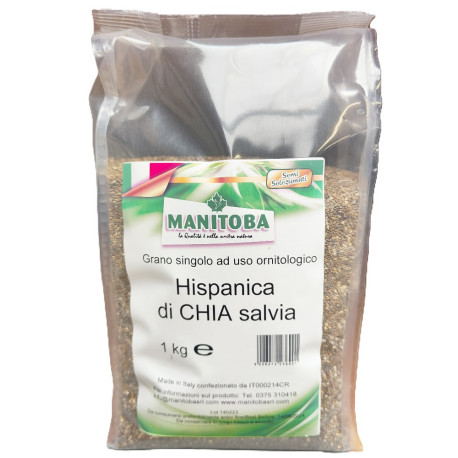





Reference: 3690/S
Please note that for orders shipped to countries outside of Europe, additional taxes, customs duties, and fees may apply upon arrival in the destination country.
These charges are the responsibility of the customer and are determined by the local customs authorities.
We recommend checking with your local customs office for more information on potential charges before placing your order.
Chia is sage. It is an annual plant up to 1 m tall whose scientific name is Salvia hispanica.
The composition of chia seed closely resembles that of other mucilaginous seeds such as flaxseeds and psyllium. Unlike flaxseed, however, chia does not have anti-nutritional factors, factors that limit the use of flaxseed without prior hot treatment. Anti-nutritional factors are cyanogenic glycosides or linatins, inhibitors of vitamin B6 that prevent its action. Chia also has a much more pleasant taste than flaxseed and birds consume it more willingly.
Chia is sage. It is an annual plant up to 1 m tall whose scientific name is Salvia hispanica.
The composition of chia seed closely resembles that of other mucilaginous seeds such as flaxseeds and psyllium. Unlike flaxseed, however, chia does not have anti-nutritional factors, factors that limit the use of flaxseed without prior hot treatment. Anti-nutritional factors are cyanogenic glycosides or linatins, inhibitors of vitamin B6 that prevent its action. Chia also has a much more pleasant taste than flaxseed and birds consume it more willingly.
Chia sage seeds are rich in flavonols (myricetol, quercetol, kaempferol), flavonol glycosides, chlorogenic acids, and caffeic acid.
They are rich in protein and fiber. With a rate, admittedly variable, ranging from 16 to 23% of protein, they are above wheat (14.7%) and corn (14%). They are also very rich in lipids containing a high proportion of omega-3 acid (alpha-linolenic acid represents 68% of lipids or 21% of the total) and a favorable omega-3 to omega-6 ratio of around 3-4.
Strong points: Chia seeds provide a good source of calcium and phosphorus and a very good source of dietary fiber and manganese.
Chia has good antioxidant activity provided by its polyphenols (chlorogenic acids, caffeic acids and flavonols).